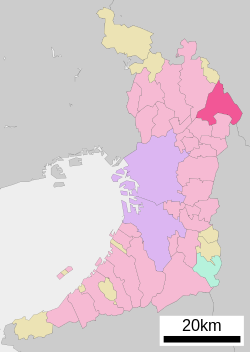Hirakata, Osaka
|
Hirakata 枚方市 |
||
|---|---|---|
| Core City | ||
|
||
 Location of Hirakata in Osaka Prefecture |
||
| Location in Japan | ||
| Coordinates: 34°49′N 135°39′E / 34.817°N 135.650°ECoordinates: 34°49′N 135°39′E / 34.817°N 135.650°E | ||
| Country | Japan | |
| Region | Kansai | |
| Prefecture | Osaka Prefecture | |
| Government | ||
| • Mayor | Hiroshi Nakatsuka | |
| Area | ||
| • Total | 65.08 km2 (25.13 sq mi) | |
| Population (August 1, 2011) | ||
| • Total | 407,465 | |
| • Density | 6,260/km2 (16,200/sq mi) | |
| Symbols | ||
| • Tree | Willow | |
| • Flower | Chrysanthemum | |
| • Bird | Common kingfisher | |
| Time zone | Japan Standard Time (UTC+9) | |
| City hall address | 2-1-20 Ogaito-chō, Hirakata-shi, Osaka-fu 573-8666 |
|
| Website | Official website | |
Hirakata (枚方市 Hirakata-shi?) is a city in northeastern Osaka Prefecture, Japan. It is known for Hirakata Park, an amusement park which includes roller coasters made of wood.
As of January 1, 2010, the city has an estimated population of 411,777, and a population density of 6,327.24 persons per km2. The total area of the city is 65.07 km2.
Eriko Aoki, author of "Korean children, textbooks, and educational practices in Japanese primary schools," stated that the city's location in proximity to both Osaka City and Kyoto contributed to its population growth of ten times its previous size from around 1973 to 2013.
The modern city was founded on August 1, 1947. On April 1, 2001, Hirakata was designated as a special city of Japan.
As of 2013 the city has about 2,000 ethnic Koreans, including permanent residents of Japan, South Korean citizens, and those aligned to North Korea. Most Hirakata Koreans, including children of school age, use Japanese names. Most ethnic Korean children in Hirakata attend Japanese public schools, while some attend Chongryon schools located in Osaka City. Many Koreans in Hirakata operate their own businesses. Hirakata has the "mother's society" or "Omoni no Kai", a voluntary association of ethnic Korean mothers. It also has branches of the Congryon and Mindan, Japan's two major Korean associations. Hirakata has no particular Korean neighborhoods.
There were about 3,000 ethnic Koreans in Hirakata in the pre-World War II period. In the 1930s Hirakata Koreans, fearful of keeping their own jobs, had negative attitudes towards Osaka-based Koreans who were looking for employment after having lost their jobs. Military construction was the most common job sector of that era's Korean population.
...
Wikipedia


